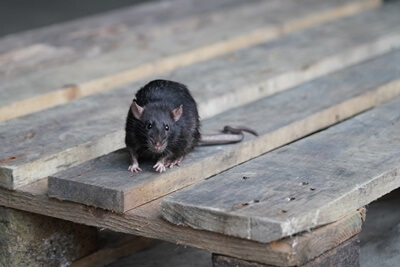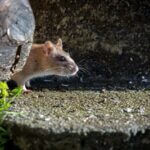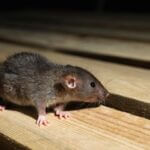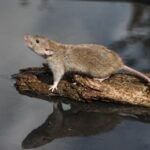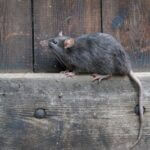The brown rat’s tail is short relative to its body size, while black rats have long tails. Brown rats have significantly lighter underbellies than black rats, and their ears are more diminutive.
Also, with characteristically plump shapes, black rats look smaller than brown rats.
Brown rats originate from Central Asia, while black rats originate from India. Although they’ve traveled via different means, both types can be found worldwide.
The black rat (ship rat) prefers to live in roof structures or high areas in tropical regions, while the brown rat (Norway rat) is more contented in colder climates.
Are Brown And Black Rats Different?
Black and brown rats may appear interchangeable, with their only difference being their fur color. However, they have different appearances, temperaments, and origins.
Here is a quick overview of what sets brown and black rats apart:
| Brown Rats | Black Rats |
| Forage in the same places | Avoid returning to places they’ve eaten. |
| Have small fur-covered ears | Large and thin ears |
| Found across the world | Tropical and coastal areas |
| Tails shorter than their bodies | Longer tails than bodies |
| Eat almost anything | Eat almost anything |
| Thicker bodies | Slender bodies |
| Nocturnal and diurnal | Nocturnal |
| Superb swimmers | Excellent climbers |
Brown Rat (Norway Rat)
Although it’s known as rattus norvegicus, or the Norway rat, the brown rat doesn’t originate from Norway. It hails from Central Asia.
It’s the most common type of rat and has been domesticated as a pet.
Brown rats are large, and their bodies are covered in dense fur, except for their:
- Ears.
- Tail.
- Nose.
- Underside.
The fur is usually grey or dark brown, but it can be a lighter shade of black in some rats. However, the legs and undersides of brown rats are lighter than the rest of the body, usually pale grey.
Some brown rats are energetic enough to swim for miles at a time, which explains why they’re so common in most urban areas.
Norway rats are quite large, ranging from 8 to 10 inches. Even though their tails look small relative to their bodies, they have an average length of 7 to 10 inches.
Adult males weigh 12 ounces, while the average weight for females is about 9 ounces. However, brown rats can exceed these sizes domestically and weigh up to 25 ounces.
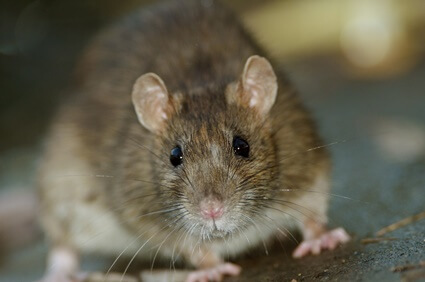
How The Brown Rat Got Its Names
The brown rat has been around for centuries if not millennia.
It first appeared in Europe in the 1300s. During this time, it earned many names. The following is a complete list of colloquial names for the brown rat and those names’ origins:
Norway Rat (Rattus Norvegicus)
This name came about hundreds of years ago. Many people believe they spread to England, and subsequently Europe, from Norwegian ships.
Common Rat
In 17th and 18th century Europe, the brown rat was prevalent in urban areas.
Sewer Rat
This name originated because brown rats are gifted swimmers, thriving in wet areas, including sewer pipes.
Street Rat
The brown rat was observed hiding in roadside sewers, garbage bins, and bushes.
Parisian Rat
By the 1800s, the brown rat had infested most of Europe.
During the Siege of Paris (1870), starvation became so widespread that many Parisians started hunting rats for food. For a short time, the rat became synonymous with the city.
Water Rat
This name arose from the brown rat’s ability to swim. It’s also because brown rats used to live in areas near water bodies, particularly oceans.
Wharf Rat
Wharves are areas where ships dock and load/unload cargo and passengers into ports. Brown rats were prominent in and around these areas, hence their association.
Hanover Rat
Most of the names associated with brown rats originated from 17th-century English culture. The Hanovers were a British royal family with German heritage who ruled between 1714 and 1831.
They were so despised that people associated them with most problems in the country. The brown rat, which caused many problems, was naturally associated with the ruling family.
Where Are Brown Rats Found?
Norway rats are primarily found in wet areas such as sewer lines, urban waterways, and kitchens. Due to environmental changes, they live in most urban areas and farmlands.
Problems with Brown Rats
There’s no indication that brown rats cause more problems than other rats. However, as brown rat populations thrive worldwide, they’re a more significant threat.
Aside from being a nuisance, brown rats can cause serious health and structural damage, including:
Diseases
Brown rats are known to transmit other common diseases like:
- Bubonic plague.
- Toxoplasmosis.
- Hantavirus.
- Typhoid.
- Salmonella.
These are contracted through inhalation or ingesting dried particles from rat urine, feces, or saliva.
Some brown rats are active carriers of rabies and rat-bite fever.
Damage
Brown rats are rabid feeders. Once they enter your home and kitchen, expect to find ruined ingredients, gnawed-on furniture, and destroyed wiring.
Black Rat (House Rat)
Rattus rattus, or black rats, aren’t synonymous with any country. They’re believed to have originated from India and moved across the world through ancient trade ships, so most people call them ship rats.
Black rats are slightly smaller than brown rats, with body lengths ranging between 6 and 8 inches. Their ears are large relative to their face size, and they have noticeably large whiskers on their muzzles.
Their tails are almost always longer than their bodies, typically measuring 7 inches or more. The long tail provides balance when the rats climb to and from their primarily arboreal habitats.
Despite the name, most black rats are not entirely black but grey-brown or a mixture of grey, black, and agouti. They have lighter-colored underparts and legs, just like brown rats.
Black rats will have finer coats, while Norway rats will have thicker coats.
Overall, the house rat is more slender than the Norway rat. Depending on their gender and subspecies, they weigh between 2 and 9 ounces.
Some attribute this low average body weight to herbivorous black rats, although they’re omnivores.
Black rats primarily feed on crops, from fruits to cereals to grains. They only feed on insects and other invertebrates in certain circumstances.
House rats are nocturnal animals, although they easily adapt to their habitat. They arise at dusk (often in groups) and eat as much as possible quickly.
If they can’t quickly finish their food, they’ll carry as much as possible to their nest, which is why many farmers consider them more destructive than brown rats.
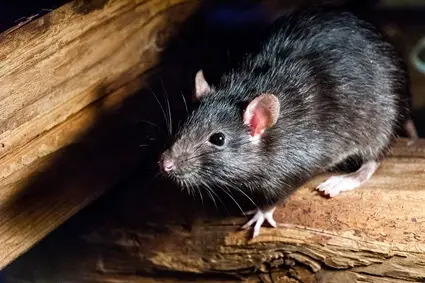
How The Black Rat Got Its Names
Since the black rat is the more common pest, this reflects its names:
Ship Rat
During the 1400s, in a period known as the Age of European Exploration, the black rat once hid in ships. These vessels transported explorers and cargo from Europe to the rest of the world.
People in Asia, Africa, and the Americas thus came to know this rodent as the ship rat.
Roof Rat
The black rat is an excellent climber and likes living in rooftops.
House Rat
The black rat thrives in warmer climates and rural areas comprising most human settlements. This, coupled with its predominantly crop-based diet, is why it’s primarily found in or near human houses and grain storage units.
Rattus Rattus
This is the species’ scientific name, as put forward by the Swedish scientist Carl Linnaeus in 1758. It translates literally to “rat rat” in Medieval Latin.
Where Are Black Rats Found?
House rats are found in warm, tropical environments. However, according to PLOS One, they’re increasingly adapting to life in colder environments.
Unlike their brown rats, black rats are poor swimmers. You’ll rarely find them near water bodies or sewer lines. They prefer to live in elevated places, such as rooftops and on the top floors of buildings.
Black rats are good at climbing surfaces and can comfortably scale a 50-foot tree in seconds.

